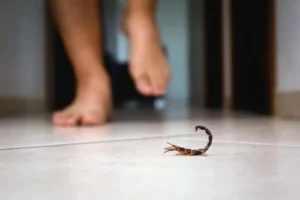Home / Blog / Termites / How To Get Rid of Flying Termites
How To Get Rid of Flying Termites

Scientifically reviewed by Daniel Baldwin, BCE, CCFS, CP-FS
-Published on January 4, 2025
-Updated on January 10, 2025
As if regular termites weren’t bad enough, flying termites can be a homeowner’s nightmare. A potential infestation of these winged termites could lead to significant structural damage if left unaddressed. Understanding how these winged insects live, why they appear, and how to eliminate them is crucial for protecting your home. This guide will give you insights into flying termites, warning signs of an infestation, and effective methods to remove them.
What Are Flying Termites?
Flying termites, also known as alates or swarmers, are the reproductive members of a termite colony. Their primary role is to leave the nest, mate, and establish new colonies. The presence of flying termites inside the house often indicates that a mature colony is nearby or that termites have already infested your home.
What Do Flying Termites Look Like?
Flying termites are often mistaken for other insects due to their appearance. Identifying these characteristics is essential for proper winged termite treatment:
- Straight antennae: Unlike ants, termites have straight, bead-like antennae.
- Uniform wings: Two pairs of wings of equal length that are longer than their body.
- Thick waist: Their bodies do not have the pinched waist that ants normally do.
Signs of a Termite Infestation
Beyond spotting the termites themselves, other signs that indicate an infestation can include:
- Discarded wings: After mating, flying termites shed their wings. Piles of wings near windowsills or doorways are a strong indicator.
- Mud tubes: Subterranean termites build mud tubes for protection and moisture retention.
- Visible wood damage: Termites eat wood from the inside out, leaving a thin veneer that may blister or peel.
- Hollow-sounding wood: Tapping on infested wood may produce a hollow sound.
Do I Have Winged Ants or Termites?
It’s fairly easy to confuse flying termites with flying ants. Correct identification is crucial for choosing the appropriate treatment. Here’s how to tell them apart:
- Antennae: Termites have straight antennae; ants have bent ones.
- Waist: Termites have a straight waist; ants have a narrow, pinched waist.
- Wings: Termites have two sets of wings equal in size, while flying ants’ front wings are larger than their hind wings.
Why Do Termites Swarm?
Termites swarm as part of their reproductive cycle—swarming typically occurs once a colony has matured and is ready to expand. The swarmers leave the nest to mate and establish new colonies. This behavior can sometimes result in termites flying in the house, especially if the colony is within the structure.
When Do Termites Swarm?
The swarming season varies by species and region but generally occurs during the spring and early summer. For most subterranean termites, swarming happens on warm days after rain. Drywood termites often swarm during late summer to early fall.
Are Flying Termites Attracted to Light?
Yes, flying termites are attracted to light sources. They often swarm around windows and doors, especially those that are brightly lit. Porch or patio lights can draw swarmers during the evening.
How to Get Rid of Flying Termites
Early detection is always key to getting rid of winged termites effectively. Here are some methods to remove them from your home:
- Vacuuming: If you notice flying termites inside the house, quickly vacuum them up and dump the contents into an outside trashcan.
- Reduce attractants: Turn off exterior lights at night and close curtains to minimize light attraction. Keep your door shut or use screens to prevent flying termites from getting inside.
- Remove water sources: Fix leaks and reduce humidity, as termites thrive in moist environments.
- Professional pest control services: Attempting to handle a flying termite infestation on your own can be challenging. The most effective way to fully eliminate these pests is with specialized, professional treatment for flying termites.
Termite Prevention Tips:
- Regular inspections: Have your home inspected annually by a professional pest control company.
- Reduce wood-to-soil contact: Ensure that wood siding, door frames, and latticework are at least six inches above the ground.
- Eliminate moisture: Repair leaking faucets, pipes, and AC units. Keep gutters and downspouts clean.
- Proper ventilation: Improve the airflow in crawl spaces to reduce humidity.
- Store wood away from your home: Keep firewood and lumber at least 20 feet away from your house.
Effective, Professional Treatment for Winged Termites
Dealing with termites requires expertise and prompt action to prevent damage to your home. At Hawx Pest Control, we specialize in identifying and eliminating termite infestations using the most effective and safe methods available. Our trained professionals will assess your unique situation and develop a customized treatment for winged termites to remove them and protect your home from future infestations. Don’t let termites compromise the safety and integrity of your property. Contact Hawx Pest Control today for a free consultation and take the first step toward achieving a safe, termite-free home—and keeping it that way.
Related Articles
Visit our blog to learn more.
→





